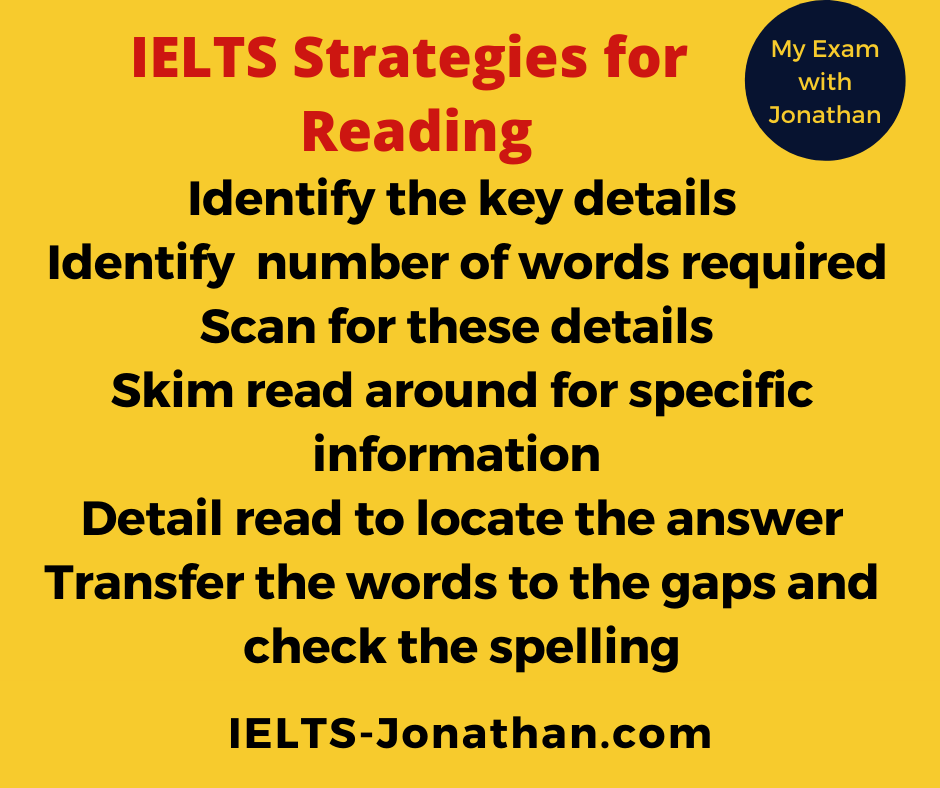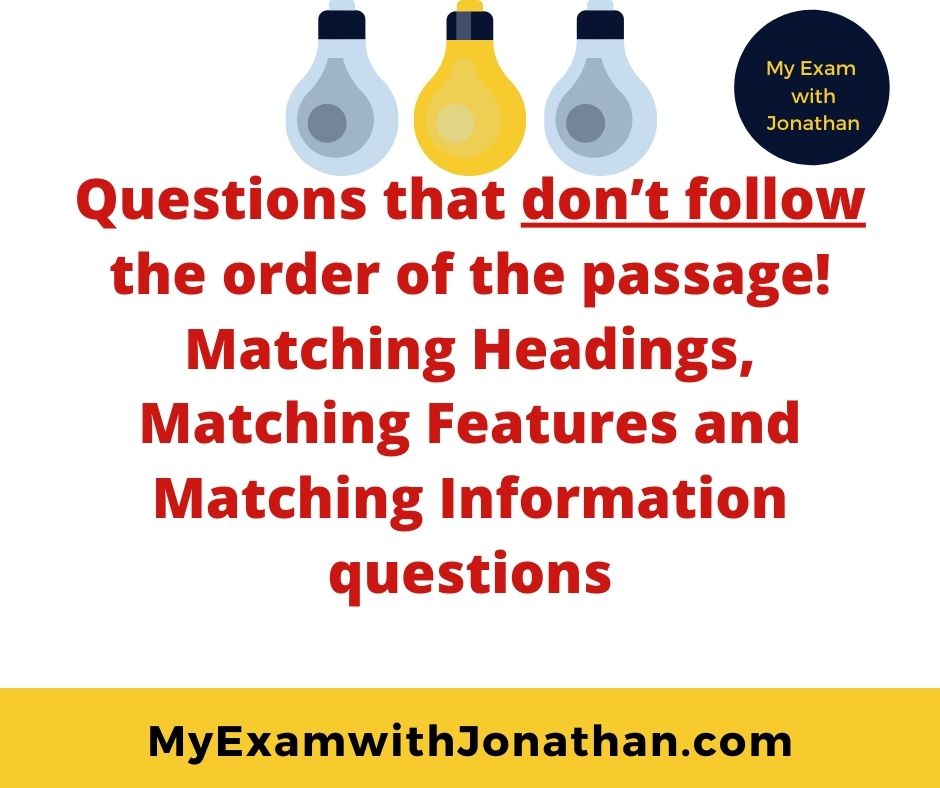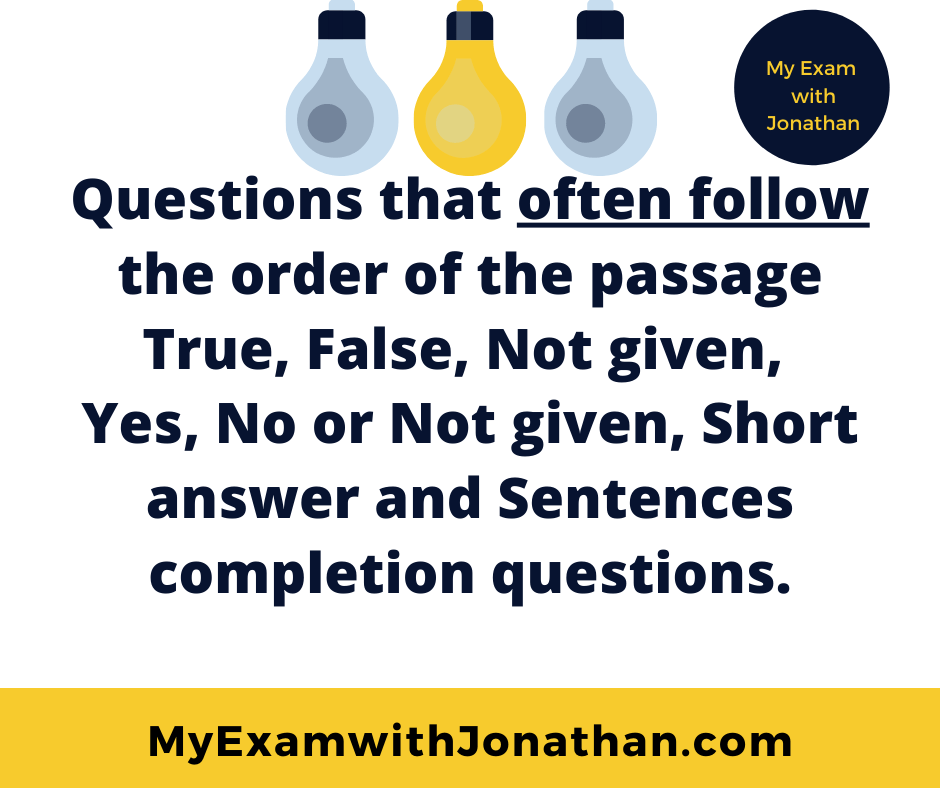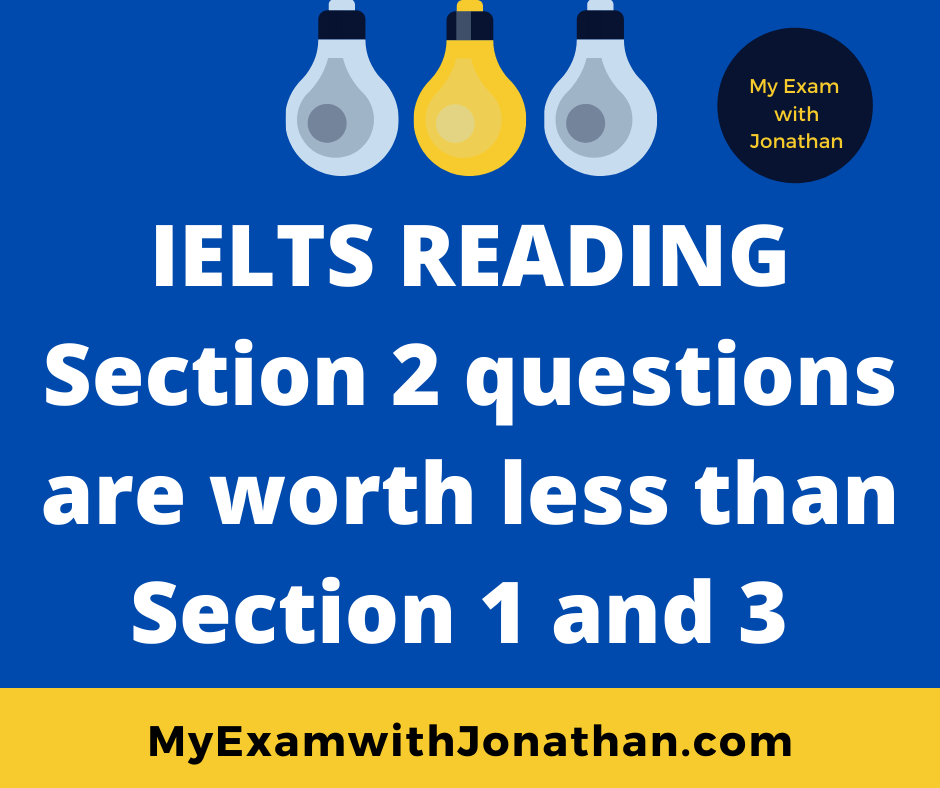There are a number of online tips and tricks that if followed claim to improve your IELTS score.
At the end of the day, success in IELTS reading is based on a few key concepts which apply to both the General and Academic Reading papers.
In order to complete the task successfully a candidate needs to be prepared and have practiced the test.
A candidate also needs to have a suitable level of vocabulary and grammar, be aware of synonyms and have developed skills for successfully reading the passages within the 60 minutes time limit of the test.
Preparation and practice provide the candidate with the experience and awareness to attempt the reading task in the most efficient way in 60 minutes, with the understanding that Section 2 is worth less marks than Section 1 and 3.
The student’s current level of vocabulary and grammar is likely to limit the IELTS reading band score, and awareness of development in this area is important.
An awareness of synonyms and the use referencing in academic texts will aid higher level language users to access the test materials.
The combined reading skills of detail, skim and scan reading can provide basic strategies to access the text efficiently which is the topic of this post.
Skimming and Scanning Strategies for IELTS Band 7
Skimming and Scanning are two essential aspects of the IELTS Reading Test, but, if you don’t really understand the techniques, you’ll end up making a mess of the exam.
Skim Reading
The purpose of skimming is to get the main ideas or the’ gist’ of the text before you look at the questions. You can do this by reading the title, any headings and a large section of the passage quickly to get an understanding of the topic and the topic context.
Scan Reading
Scanning is the most important skill. Once you have an understanding of the context and arrangement of text, scanning is used to identify the possible answers in the IELTS Reading test. Again, the technique is not difficult, and can be learned but you need to practise often to be able to read quickly.
IELTS Skimming Skills
There are a number of questions types that never follow the order of the passage. The reasons for this is not to trick you but to test the first reading skill which is skimming.
Skimming considers other certain aspects of reading skills, and in this case, it is to locate information in a passage. Questions are never in the order of the passage, as the test would not be valid, reliable or testing you and would be far too easy.
Questions that don’t follow the order of the passage are; Matching Headings, Matching Features and Matching Information questions.
How to skim an article?
Skimming is not a difficult technique to follow and if you practise and learn to master it, understanding the second skill, scanning, becomes easier to learn. I recommend you only use IELTS papers to perfect this technique, but you can apply it to online reading in general.
Here’s how you skim read:
- When you have an IELTS paper or an article, don’t just read the questions first, read the whole passage in sections to gain an understanding of the main topic.
- Underline any sentence, word or keyword that you think is important, but remember, the main purpose at this stage is to understand the gist. There’s no wrong or write keywords, you only have to mark what you think is related to the main concept within the text.
Points to bear in mind while skimming
- Don’t read the questions before you skim.
If you do, you’ll tend to only try to look for answers. If you skim first and then read the passage then you’ll be able to scan for the answers with an understanding of how the text is arranged.
- Skim the whole passage, not just the first lines of a paragraph
Often the main idea is hidden between paragraphs or in the paragraphs near the end, so it is important to read the entire text quickly. If you don’t want to read it completely, glance at some repeated words or synonyms as these words may indicate the main idea of the text.
Choosing the wrong answer
The most common reason for wrong answers is reading the wrong section of a passage.
The text will use plenty of synonyms and repeated words which may suggest this is where the answer is but skimming around these words will help you decide if this section is relevant to the question you are answering.
Skim reading effectively by practising the following steps
- Read the question (note if it is the type of question that follows the order of the passage) and identify the key phrases and terms
- Skim the passage for words and synonyms
- Skim read around the words to identify whether this is likely to be the area with the answer
- Read in detail to confirm and locate the answer
IELTS Scanning Skills
Scanning is probably the most important skill. Once you have an understanding of the context and arrangement of text, scanning is used to identify the possible answers in the IELTS Reading test. Again, the technique is not difficult, and can be learned, but you need to practise often to be able to read quickly.
How to scan a text?
It’s physically not practical to read the entire text in only 60 minutes. You’ll have three texts to read and 40 questions to answer, which is why it becomes all the more important to learn to scan read.
Did you know that often questions for the reading passage appear in the same order as the text itself?
So, a big tip is to train yourself to answer certain questions in the order they appear. The passage is organised in a logical pattern, and for some questions the purpose of the test is to show that you can focus on a particular meaning or aspect of a certain part of the passage.
Questions that often follow the order of the passage are; True, False, Not given, Yes, No or Not given, Short answer questions and Sentences completion questions.
If you are working on improving your vocabulary and grammar, it is a good idea to practise these test questions, so you can master the skill.
Again, these questions are not designed to trick you; they test your ability to scan and locate specific information.
There is no one way of scanning a text, you are simply practising a number of skills while scanning an article, but, very quickly:
- Remember, in contrast to skimming, it IS a good idea to read the questions BEFORE scanning the article.
- When you’ve read the questions, spotting keywords related to those questions should become easier so you can circle anything that is related to that keyword.
- When you’re reading, don’t read the text word by word, move your eyes over the text and look for specific information or keywords. These could be names, numbers, dates or any keyword from the questions.
- Once you have found the keywords, read the question once more, and the sentences with a circled or underlined word. When you believe you have the right answer, note it down in your own words.
Combining the skills for other question types and skills
Questions that ask you to complete notes, diagrams or summaries are often not in the order of the passage.
These questions require you to organise information from the passage in different ways. For example, a diagram may require reorganisation of the text, a flowchart may show chronological order and notes may require information under headings.
Questions that are not often in the order of the passage are; Flowchart completion, Diagram completion, Summary completion and Notes completion
A way to approach these questions is
- Identify the key details, for example, are they headings, notes or labels
- Identify that you have to transfer words exactly from the text and how many words
- Scan the reading text for these details
- Skim read around to identify you have the specific information
- Detail read to locate the answer
- Transfer the words to the gaps and check the spelling
By the way, you now know that some questions follow the order of the passage but did you know that section 1 and 3 questions are worth more marks than section 2?
So, you should not spend too long on section 2 or you may lose marks.
Using official test materials
Remember, you must practice scanning to become competent. Train yourself to scan a text using various official IELTS practice tests and IELTS preparation books. You can find official samples here.
You can use online IELTS practice materials, but beware! I have found this are often inaccurate and more importantly, the questions are not a reflection of the real test.
So, remember, you can practice skimming and scanning with online IELTS practice materials, newspapers, magazines, books and comprehension texts to improve the basic skills of skimming and scanning but to be valid, only official materials should be used for a fair skills assessment.
Focused Practice for IELTS Reading
Now that you can see the reasons for using official IELTS materials, what kind of practice should an IELTS student follow? Well, if you notice in most text books, the skills needed for reading are broken down into micro skills. This means that students can work on weaker areas, and identify strategies to improvement.
The same applies to doing official tests.
Don’t so test after test expecting to see results, break down the tests into section and practice improvements in each part, one, two or three.
Monitor these scores you get to identify which sections of the test you should work on more.
Developing Skimming
Remember skimming is not about the details, but the general gist of the text. If you have weaknesses in this area, to focus your practice in this skill, select a passage for an official test and spend a few minutes skim reading it to try and gather the general information. Depending on the passage and section of the test, aspects you should be looking for are
- the general topic or area of study
- is it restricted to one country or study or more than one?
- does it refer to the past, present of future research or trend?
- is the stance positive, neutral or negative?
Developing Scanning
You follow the same approach here, but focus the skills slightly differently by considering key details. Take a passage, again, from an official test and take a look at some of the associated questions. Make a note of at least 5 key details in the questions, such as a name, a date or an unknown technical term and time yourself to see how quickly you can locate the key details in the text.
You will probably find this a small challenge at first, but this activity will likely help you deal with locating information that has been paraphrased and also deal with recognising synonyms used in the passage.
If you create a habit of regularly doing this, then you are likely to learn to do this in the real test as well.
Developing Speed in Reading
The average native speaker is able to read around 100 words within 20 seconds. While this seems a lot, it is still possible for a good non-native speaker to get close to that figure, maybe 30 to 40 seconds, if you can train yourself not to read every single word.
One technique to develop increased reading speed is training with official IELTS materials.
Select a genuine reading text, and then select a passage, for example Section 1. Next select a paragraph and count the words in the passage. When you reach a sentence that contains the one hundredth word, mark the end of the sentence and repeat again and again until the end. You could do this for the whole text, but don’t be overambitious and you are trying to develop your reading speed and this will happen gradually.
Set a timer on your phone for 40 seconds and begin to skim read the first 100 words. Reset the timer and read again, repeating the process until the end of the passage. If you are finishing the 100 words before the 40 seconds then reduce the number to 35 or 30.
Once you have finished, the task is to recite anything you can remember. You are unlikely to remember particular details about the text, but if you read effectively you should be able to gain an overall impression of the passages. Gaining an overall impression of a text, or a picture, if you like, is very useful in comprehension of a reading passage. This particularly works well if you have a partner to work and practice with.
Try to gain the gist of other sections of the reading test and other passages using the same technique and you should gain the confidence and skills to perform well in a test situation.
Remember, using official materials will make this effort valid.
Strategies to Improve your Reading Score
- Understanding your current weaknesses and developing strengths in these areas is probably the most useful strategy in improving your score. This is a much better strategy than simply doing test after test, hoping you will get luck. Any gains you make are likely to be modest and you probably continue to make the same mistakes
- Notice I keep saying it is important to use official materials that you will use in the test. Reading literature or a scientific paper are very different processes, and the same applies to reading genuine test materials written by trained test writers and those that claim to be. If you use materials that claim to be genuine, then you won’t get a fair assessment of your strengths and weaknesses.
- One way of identifying weaknesses is to go back to tests you have completed and notice the sections you got the most wrong answers. Section 2 and 3 mistakes are likely to be related to language, so it is important to revisit the text and identify why you chose the wrong answer. If you have a teacher, go through the text together.
- Are there particular questions which are consistently challenging. This can be related to language too, for example, you may need to work on questions that ask why, where, what or how.
- Are there question formats that are consistently wrong. This can be related to training and understanding of the question function. For example, Yes, No, Not Given questions are quite different to True, False, Not Given questions.
The importance of Timing
The final strategy for effective reading is an understanding of timing. Although there are 40 questions, Section 2 questions are not worth the same mark as Section 1 and Section 3. Logically, this suggests that these questions are more challenging and so you need to consciously allow a bit more time in these areas. You should probably aim for 3 minutes to skim read each passage, and allow a minute for each questions. If you remember that some questions come in the order of the passage, skip the question that is taking up too much time, use the question number to guide you and come back to it at the end
‘How and If ‘ to get to Band 7 or above
Using a IELTS calculator, you can work out that to score Band 7 you need answer at least 30 out of 40 questions correctly.
This means there are 5 further questions for Band 8 and 10 for Band 9. Don’t waste time answering these questions, focus on the 30 you need!
Finally, as an ex-exam invigilator, I often saw students still transferring their answers to the answer sheet at the end of the test.
In the exam you are given a 10 and 5 minute end of test warning, so don’t let those higher level questions rob you of your Band 7 ambition by not completing the marking sheet.
I’m Jonathan I’ve taught IELTS and University English in more than a dozen universities and schools around the world. I’m a parent, traveller and passionate about language teaching and helping students achieve their dreams. Whilst living in Austria or working in Asia, I run IELTS courses to help students get to where they want to be. If you are serious about IELTS, connect with me to see how I can help you.








[…] you need to brush up on what these skills are, I’ve prepared a skimming and scanning post with practical explanations of these important IELTS […]